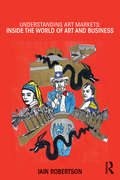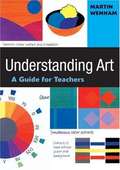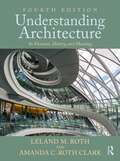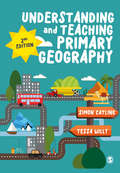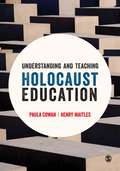- Table View
- List View
Understanding Audiences and the Film Industry (Understanding the Moving Image)
by Roy StaffordBrings together an introduction to academic study of audiences as 'readers' of films and an investigation into how the film industry perceives audiences as part of its industrial practices. The appraoch draws on ideas from film, media and cultural studies to present an insight to what makes the biggest box office films attractive to audiences.
Understanding Art Markets: Inside the world of art and business
by Iain RobertsonThe global art market has recently been valued at close to $50bn - a rise of over 60% since the global financial crisis. These figures are driven by demand from China and other emerging markets, as well as the growing phenomenon of the artist bypassing dealers as a market force in his/her own right. This new textbook integrates, updates and enhances the popular aspects of two well-regarded texts - Understanding International Arts Markets and The Art Business. Topics covered include: Emerging markets in China, East Asian, South East Asian, Brazilian, Russian, Islamic and Indian art, Art valuation and investment, Museums and the cultural sector. This revitalized new textbook will continue to be essential reading for students on courses such as arts management, arts marketing, arts business, cultural economics, the sociology of arts, and cultural policy.
Understanding Art Markets: Inside the world of art and business
by Iain RobertsonThe global art market has recently been valued at close to $50bn - a rise of over 60% since the global financial crisis. These figures are driven by demand from China and other emerging markets, as well as the growing phenomenon of the artist bypassing dealers as a market force in his/her own right. This new textbook integrates, updates and enhances the popular aspects of two well-regarded texts - Understanding International Arts Markets and The Art Business. Topics covered include: Emerging markets in China, East Asian, South East Asian, Brazilian, Russian, Islamic and Indian art, Art valuation and investment, Museums and the cultural sector. This revitalized new textbook will continue to be essential reading for students on courses such as arts management, arts marketing, arts business, cultural economics, the sociology of arts, and cultural policy.
Understanding Art Education: Engaging Reflexively with Practice
by Nicholas Addison Lesley Burgess John Steers Jane TrowellWhat is distinctive about art and design as a subject in secondary schools? What contribution does it make to the wider curriculum? How can art and design develop the agency of young people? Understanding Art Education examines the theory and practice of helping young people learn in and beyond the secondary classroom. It provides guidance and stimulation for ways of thinking about art and design when preparing to teach and provides a framework within which teachers can locate their own experiences and beliefs. Designed to complement the core textbook Learning to Teach Art and Design in the Secondary School, which offers pragmatic approaches for trainee and newly-qualified teachers, this book suggests ways in which art and design teachers can engage reflexively with their continuing practice. Experts in the field explore: The histories of art and design education and their relationship to wider social and cultural developments Creativity as a foundation for learning Engaging with contemporary practice in partnership with external agencies The role of assessment in evaluating creative and collaborative practices Interdisciplinary approaches to art and design Developing dialogue as a means to address citizenship and global issues in art and design education. Understanding Art Education will be of interest to all students and practising teachers, particularly those studying at M Level, as well as teacher educators, and researchers who wish to reflect on their identity as an artist and teacher, and the ways in which the subject can inform and contribute to education and society more widely.
Understanding Art Education: Engaging Reflexively with Practice
by Nicholas Addison Lesley Burgess John Steers Jane TrowellWhat is distinctive about art and design as a subject in secondary schools? What contribution does it make to the wider curriculum? How can art and design develop the agency of young people? Understanding Art Education examines the theory and practice of helping young people learn in and beyond the secondary classroom. It provides guidance and stimulation for ways of thinking about art and design when preparing to teach and provides a framework within which teachers can locate their own experiences and beliefs. Designed to complement the core textbook Learning to Teach Art and Design in the Secondary School, which offers pragmatic approaches for trainee and newly-qualified teachers, this book suggests ways in which art and design teachers can engage reflexively with their continuing practice. Experts in the field explore: The histories of art and design education and their relationship to wider social and cultural developments Creativity as a foundation for learning Engaging with contemporary practice in partnership with external agencies The role of assessment in evaluating creative and collaborative practices Interdisciplinary approaches to art and design Developing dialogue as a means to address citizenship and global issues in art and design education. Understanding Art Education will be of interest to all students and practising teachers, particularly those studying at M Level, as well as teacher educators, and researchers who wish to reflect on their identity as an artist and teacher, and the ways in which the subject can inform and contribute to education and society more widely.
Understanding Art: A Guide for Teachers (PDF)
by Martin WenhamIn any area of the curriculum, children need to learn concepts, facts and skills through first-hand experience. In art, such learning depends on exploring and experimenting with the visual language through which artists communicate, and the visual elements such as line, colour and shape.
Understanding Architecture Through Drawing
by Brian EdwardsThis second edition is fully revised and updated and includes new chapters on sustainability, history and archaeology, designing through drawing and drawing in architectural practice. The book introduces design and graphic techniques aimed to help designers increase their understanding of buildings and places through drawing. For many, the camera has replaced the sketchbook, but here the author argues that freehand drawing as a means of analyzing and understanding buildings develops visual sensitivity and awareness of design. By combining design theory with practical lessons in drawing, Understanding Architecture Through Drawing encourages the use of the sketchbook as a creative and critical tool. The book is highly illustrated and is an essential manual on freehand drawing techniques for students of architecture, landscape architecture, town and country planning and urban design.
Understanding Architecture Through Drawing
by Brian EdwardsThis second edition is fully revised and updated and includes new chapters on sustainability, history and archaeology, designing through drawing and drawing in architectural practice. The book introduces design and graphic techniques aimed to help designers increase their understanding of buildings and places through drawing. For many, the camera has replaced the sketchbook, but here the author argues that freehand drawing as a means of analyzing and understanding buildings develops visual sensitivity and awareness of design. By combining design theory with practical lessons in drawing, Understanding Architecture Through Drawing encourages the use of the sketchbook as a creative and critical tool. The book is highly illustrated and is an essential manual on freehand drawing techniques for students of architecture, landscape architecture, town and country planning and urban design.
Understanding Architecture Its Elements, History, and Meaning: Its Elements, History, And Meaning
by Leland M. Roth Amanda C. Roth ClarkThe widely acclaimed and beautifully illustrated Understanding Architecture is now revised and expanded in its fourth edition, vividly examining the structure, function, history, and meaning of architecture, from prehistory to the present, in ways that are both accessible and engaging.
Understanding Architecture
by Hazel Conway Rowan RoenischA comprehensive introduction to architecture and architectural history and exceptional in its approach, this book explores architecture as a current practice in relation to history and in relation to the wider context of cultures, conservation and the environment. This new edition brings in the new emphasis on sustainability, urbanism, urban regeneration and cultural identity, in order to take a holistic approach to the subject of architecture. Highly illustrated, this book enables the reader to make sense of the experience of architecture and the built environment by understanding more about the form, construction, meaning and history of the subject.
Understanding Architecture: An Introduction to Architecture and Architectural History (PDF)
by Hazel Conway Rowan RoenischA comprehensive introduction to architecture and architectural history and exceptional in its approach, this book explores architecture as a current practice in relation to history and in relation to the wider context of cultures, conservation and the environment. This new edition brings in the new emphasis on sustainability, urbanism, urban regeneration and cultural identity, in order to take a holistic approach to the subject of architecture. Highly illustrated, this book enables the reader to make sense of the experience of architecture and the built environment by understanding more about the form, construction, meaning and history of the subject.
Understanding Architecture: Its Elements, History, and Meaning
by Leland M. RothThis widely acclaimed, beautifully illustrated survey of Western architecture is now fully revised throughout, including essays on non-Western traditions. The expanded book vividly examines the structure, function, history, and meaning of architecture in ways that are both accessible and engaging.Significant features of the third edition include: Increased global coverage, with new essays on Africa, Japan, China, India, Islamic architecture, and the architecture of the Americas. A new chapter covering twenty-first century architecture. Updated coverage of sustainable and green architecture and its impact on design. Revised historical survey and expanded and illustrated timeline. Thoroughly revised and expanded art program, including more than 650 black and white images?135 new to this edition, and more than 200 line art drawings created by author Leland Roth. A new 32-page, full color insert features more than 50 new color images.Understanding Architecture continues to be the only text in the field to examine architecture as a cultural phenomenon as well as an artistic and technological achievement with its straightforward, two-part structure: The Elements of Architecture and The History and Meaning of Architecture. Comprehensive and clearly written, Understanding Architecture is a classic survey of architecture.
Understanding Architecture: Its Elements, History, and Meaning (Architecture And Planning Ser.)
by Leland M. RothThis widely acclaimed, beautifully illustrated survey of Western architecture is now fully revised throughout, including essays on non-Western traditions. The expanded book vividly examines the structure, function, history, and meaning of architecture in ways that are both accessible and engaging.Significant features of the third edition include: Increased global coverage, with new essays on Africa, Japan, China, India, Islamic architecture, and the architecture of the Americas. A new chapter covering twenty-first century architecture. Updated coverage of sustainable and green architecture and its impact on design. Revised historical survey and expanded and illustrated timeline. Thoroughly revised and expanded art program, including more than 650 black and white images?135 new to this edition, and more than 200 line art drawings created by author Leland Roth. A new 32-page, full color insert features more than 50 new color images.Understanding Architecture continues to be the only text in the field to examine architecture as a cultural phenomenon as well as an artistic and technological achievement with its straightforward, two-part structure: The Elements of Architecture and The History and Meaning of Architecture. Comprehensive and clearly written, Understanding Architecture is a classic survey of architecture.
Understanding Animation
by Paul WellsFirst Published in 1998. Routledge is an imprint of Taylor & Francis, an informa company.
Understanding Animation
by Paul WellsFirst Published in 1998. Routledge is an imprint of Taylor & Francis, an informa company.
Understanding and Teaching Primary History
by Dr. James PercivalPrimary history is one of the richest areas of teaching and learning, but in order to teach it well trainee teachers need a strong understanding of key historical concepts and the dynamics of the national curriculum. Combining a detailed focus on the core skills and principles underpinning good history teaching, this book helps students to: · appreciate the key concepts that underpin historical understanding · engage deeply with the programmes of study for Key Stage 1 and 2 · assess children&’s historical understanding · apply a cross-curricular approach to teaching This is essential reading for anyone studying primary history on initial teacher education courses including undergraduate (BEd, BA with QTS), postgraduate (PGCE, SCITT), school-based training (School Direct, Teach First), and qualified teachers who wish to enhance their professional knowledge.
Understanding and Teaching Primary History
by Dr. James PercivalPrimary history is one of the richest areas of teaching and learning, but in order to teach it well trainee teachers need a strong understanding of key historical concepts and the dynamics of the national curriculum. Combining a detailed focus on the core skills and principles underpinning good history teaching, this book helps students to: · appreciate the key concepts that underpin historical understanding · engage deeply with the programmes of study for Key Stage 1 and 2 · assess children&’s historical understanding · apply a cross-curricular approach to teaching This is essential reading for anyone studying primary history on initial teacher education courses including undergraduate (BEd, BA with QTS), postgraduate (PGCE, SCITT), school-based training (School Direct, Teach First), and qualified teachers who wish to enhance their professional knowledge.
Understanding and Teaching Primary History
by Dr. James PercivalPrimary history is one of the richest areas of teaching and learning, but in order to teach it well trainee teachers need a strong understanding of key historical concepts and the dynamics of the national curriculum. Combining a detailed focus on the core skills and principles underpinning good history teaching, this book helps students to: · appreciate the key concepts that underpin historical understanding · engage deeply with the programmes of study for Key Stage 1 and 2 · assess children&’s historical understanding · apply a cross-curricular approach to teaching This is essential reading for anyone studying primary history on initial teacher education courses including undergraduate (BEd, BA with QTS), postgraduate (PGCE, SCITT), school-based training (School Direct, Teach First), and qualified teachers who wish to enhance their professional knowledge.
Understanding and Teaching Primary Geography (Achieving QTS Series)
by Tessa Willy Professor Simon J CatlingThis book outlines how good teaching of primary geography can extend children's world awareness and help them make connections between their environmental and geographical experiences. Chapters offer guidance on important learning and teaching issues as well as the use and creation of resources from the school environment to the global context. It covers all the key topics in primary geography including: understanding places physical and human geography environmental sustainability learning outside the classroom global issues citizenship and social justice. Summaries, classroom examples and practical and reflective tasks are included throughout to foster understanding and support the effective teaching of primary geography.
Understanding and Teaching Primary Geography (Achieving QTS Series)
by Tessa Willy Professor Simon J CatlingThis book outlines how good teaching of primary geography can extend children's world awareness and help them make connections between their environmental and geographical experiences. Chapters offer guidance on important learning and teaching issues as well as the use and creation of resources from the school environment to the global context. It covers all the key topics in primary geography including: understanding places physical and human geography environmental sustainability learning outside the classroom global issues citizenship and social justice. Summaries, classroom examples and practical and reflective tasks are included throughout to foster understanding and support the effective teaching of primary geography.
Understanding and Teaching Holocaust Education (1st edition) (PDF)
by Paula Cowan Professor Henry MaitlesThe Holocaust is a controversial and difficult teaching topic that needs to be approached sensitively and with an awareness of the complex and emotive issues involved. This book offers pragmatic pedagogical and classroom-based guidance for teachers and trainee teachers on how to intelligently teach holocaust education in a meaningful and age-appropriate way. Key coverage includes: Practical approaches and useful resources for teaching in schools; Holocaust education and citizenship; Holocaust remembrance as an educational opportunity; How to explore the topic of anti-semitism in the classroom; Exploring international perspectives on holocaust education. Related ISBN: 9781473988026 (EPUB), 9781473987265 (PDF).
Understanding and Teaching Holocaust Education (1st edition)
by Paula Cowan Professor Henry MaitlesThe Holocaust is a controversial and difficult teaching topic that needs to be approached sensitively and with an awareness of the complex and emotive issues involved. This book offers pragmatic pedagogical and classroom-based guidance for teachers and trainee teachers on how to intelligently teach holocaust education in a meaningful and age-appropriate way. Key coverage includes: Practical approaches and useful resources for teaching in schools; Holocaust education and citizenship; Holocaust remembrance as an educational opportunity; How to explore the topic of anti-semitism in the classroom; Exploring international perspectives on holocaust education. Related ISBN: 9781473988026 (EPUB).
Understanding and Teaching Holocaust Education
by Paula Cowan Professor Henry MaitlesThe Holocaust is a controversial and difficult teaching topic that needs to be approached sensitively and with an awareness of the complex and emotive issues involved. This book offers pragmatic pedagogical and classroom-based guidance for teachers and trainee teachers on how to intelligently teach holocaust education in a meaningful and age-appropriate way. Key coverage includes: Practical approaches and useful resources for teaching in schools Holocaust education and citizenship Holocaust remembrance as an educational opportunity How to explore the topic of anti-semitism in the classroom Exploring international perspectives on holocaust education
Understanding and Teaching Holocaust Education
by Paula Cowan Professor Henry MaitlesThe Holocaust is a controversial and difficult teaching topic that needs to be approached sensitively and with an awareness of the complex and emotive issues involved. This book offers pragmatic pedagogical and classroom-based guidance for teachers and trainee teachers on how to intelligently teach holocaust education in a meaningful and age-appropriate way. Key coverage includes: Practical approaches and useful resources for teaching in schools Holocaust education and citizenship Holocaust remembrance as an educational opportunity How to explore the topic of anti-semitism in the classroom Exploring international perspectives on holocaust education
Understanding and Interpreting Machine Learning in Medical Image Computing Applications: First International Workshops, Mlcn 2018, Dlf 2018, And Imimic 2018, Held In Conjunction With Miccai 2018, Granada, Spain, September 16-20, 2018, Proceedings (Lecture Notes in Computer Science #11038)
by Danail Stoyanov Zeike Taylor Seyed Mostafa Kia Ipek Oguz Mauricio Reyes Anne Martel Lena Maier-Hein Andre F. Marquand Edouard Duchesnay Tommy Löfstedt Bennett Landman M. Jorge Cardoso Carlos A. Silva Sergio Pereira Raphael MeierThis book constitutes the refereed joint proceedings of the First International Workshop on Machine Learning in Clinical Neuroimaging, MLCN 2018, the First International Workshop on Deep Learning Fails, DLF 2018, and the First International Workshop on Interpretability of Machine Intelligence in Medical Image Computing, iMIMIC 2018, held in conjunction with the 21st International Conference on Medical Imaging and Computer-Assisted Intervention, MICCAI 2018, in Granada, Spain, in September 2018. The 4 full MLCN papers, the 6 full DLF papers, and the 6 full iMIMIC papers included in this volume were carefully reviewed and selected. The MLCN contributions develop state-of-the-art machine learning methods such as spatio-temporal Gaussian process analysis, stochastic variational inference, and deep learning for applications in Alzheimer's disease diagnosis and multi-site neuroimaging data analysis; the DLF papers evaluate the strengths and weaknesses of DL and identify the main challenges in the current state of the art and future directions; the iMIMIC papers cover a large range of topics in the field of interpretability of machine learning in the context of medical image analysis.

